Mount conversion to Canon EF mount to use Canon supertele 300 mm/ 2.8 L on Canon EOS DSLR cameras
To use this fine old FD lens - to my sorrow it has fungus - I converted it to Canon EF mount.
Original Canon FD lenses have complex ball bearings in the mount. This conversion is NOT for lens mount conversion beginners! To build it back to FD mount is hard, not only because of these ball bearings. If one build directly a new iris lever inside, the conversion is reversible.
There are different ways to convert this lens to Canon EF mount. This is one of the ways. Another one is to use a short FD-EF adapter and change the internal focussing (IF) system. I am not sure wheter this change in the optical system has a bad influence on the image quality. Some say no. I think there is a reason why Canon has not implemented a shorter minimum focus distance in this lens - what seems easy with this kind of internal focus group altering. So I suppose that the image quality decrease with such an operation.
For my undestanding the IF modification is like getting a altered zoom range in a zoom lens.
Here my way without changing the optical setup:
The old FD mount is not easy to disassemble!
From the mount sind eyou could get some parts of the mount away, but the iris mechanics with all the levers and rings not.
For the preparation of the work it helps to take a cheap 48mm filter inside the filter holder - in case some of the ball bearings drop onto that filter - this was the case in my first try.
So the UV filter has a real protection function :-)
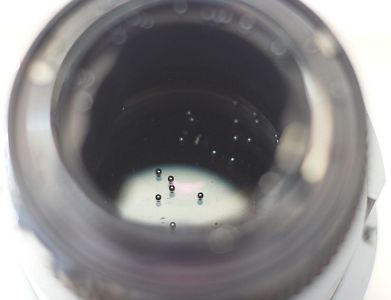
To get further one need to seperate the front and back part of the lens. For this you need to open small set screws, after that you could screw that flange away - if you take the filter holder out.
Now you have the front part with all the lenses, and the back part with the iris and the mount seperated.
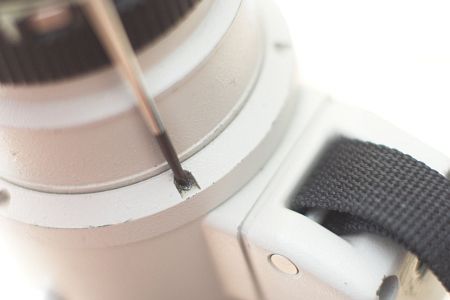
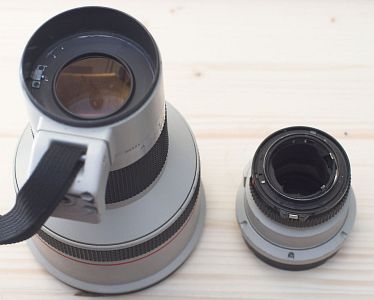
Even after this we are not ready!
The iris assembly needs to be
removed from the tube. For this I have removed the four screws beneath the rubber blanket around the filter drawer. The small metal spring parts that are around the drawer must be removed after this.
Now one should open the iris. With a longer screwdriver through the iris opening I could open four screws. After that I get the iris assembly and some mechanics.
Up to now was the easy part of the operation!


Here in the picture you could see the iris lever that is inside the iris fork of the iris assembly. I think in this picture you see my own made iris lever - its bright. As I remember the original lever is dark, and not that good to recognize in the picture - because of that I took this one.
Our own made laver need to get into this place, without scratching the parts around.
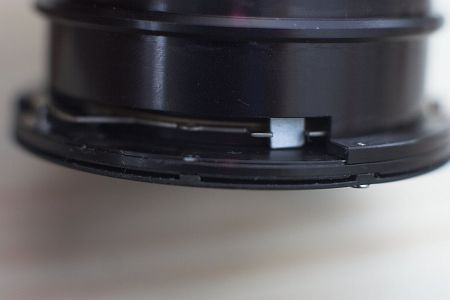
But first we need to make a new iris mechanics for the mount part, and the EF mount.
As a new mount I took a M42-Canon EF adapter ring. One has to flag the "upside" = iris-index position on this mount adapter!
I reccomend to do this on a cheap test camera, like a (film) EOS 500n.
Now we need the positions for the screw holes.
For that I glued the original mount part to the
M42-EF adapter - with some cheap hot glue that one could easily remove after the work.
Take care to glue it in that position, that the "upside" of the original Canon part and the "upside" of the M42-EF adapter are the same!
And take care, that both parts show in the same direction - booth camera mount side on one direction - not front to front!
The two parts need to be very good centered!
One hole should be on the "upside" position.
With the glued parts you make the holes with a drill. Best is a box column drill. A metric 2.5mm drill should have the same diameter like the original part holes. Be carefully to make no damage on the original part! You need longer 1.9mm screws, that have the same pitch like the original screws - they are hard to find! I think I have mine from analogue cameras that I have dissected earlier. It is very helpful to strip down old cameras and lenses before their disposal! The screws and springs could help in other repairs oth conversions!
After drilling the holes, the glue could be broken, and the adapter needs more work on it.
On the M42-EF adapter I make carefully the holes for the screw heads, with first 3.0mm drill, and afterwards 3.4mm drill.
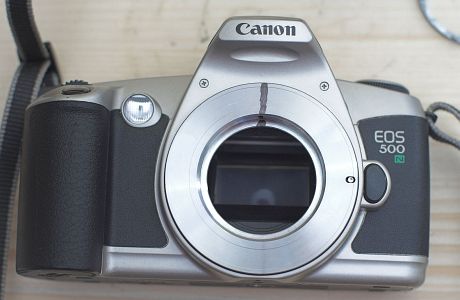
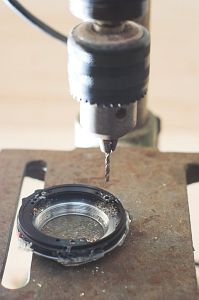
The M42-EF adapter now should fit to the FD lens.
Later you probably need some washers between the M42-EF adapter
and the lens, in order to make the iris ring moveable.
To make use of the iris, you need to make a copy of the original iris lever
/ arm / crank.
Her is the original Canon FD part:
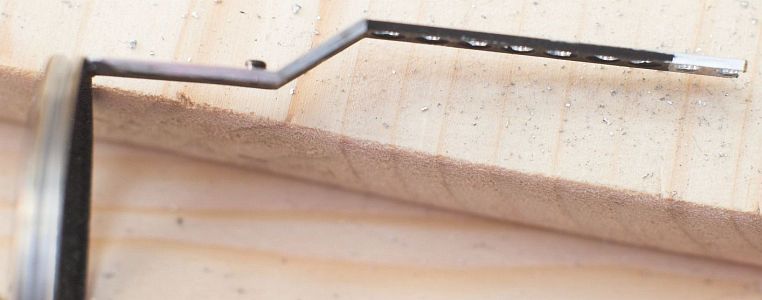
Don't try to bend the old part for your lens, the risk is high that it breaks! That happens to me :-)
I made a iris lever copy with 1.5mm thick aluminium. You need to bend exact, because the material gets weak during bending it several times.
The base plate that holds the iris lever and make the connection between the iris ring and the iris lever is a bit complex. See the image bellow.
For the first test I bonded these parts with hot glue, and after that I made small holes and with a tap I make a screw connection. It is not perfect, because partly the screw is not full inside the metal. Because of that I made ~ 4 screws.
With the soft part of velcro tape I make a kind of support and light-shield. Far from perfect!
Proably after reading this, you should check the alternative methods to use your FD 300/2.8L lens :-)
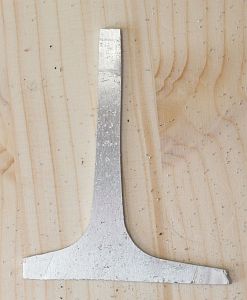
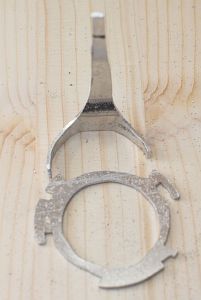
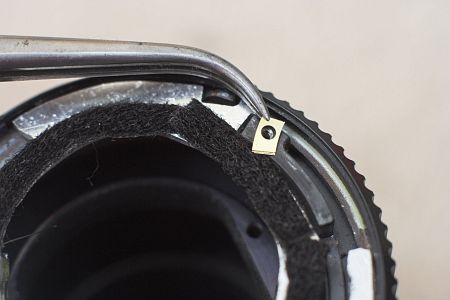
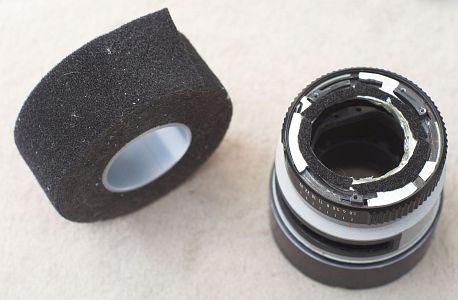
Her you see the result: A converted Canon FD 300mm f/2.8 L lens on the Canon EOS 5D camera. The iris is usabel from 2.8 to 16.
Not sharpend test image.
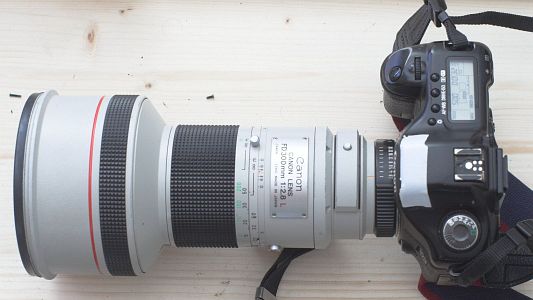
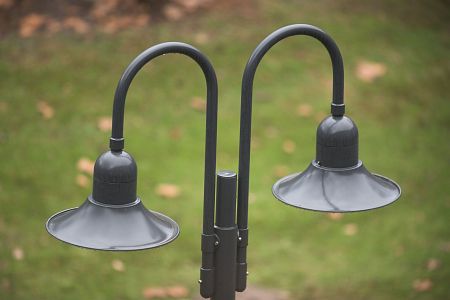
Please be aware: All you do is on your own risk! I could not give you support!
More images made with this lens after the mount conversion:
Landschaft 1, Morgenrot, Strommasten, Bach
Some images I made before this conversion - with a DIY made FD-EF adapter or a DIYconverted Canon FD 1.4 teleconverter
Libellen 1, Libellen 2, Graureiher,
Graureiher 2, Flamingos, Flamingo 2
This lens is great. it is also usable for medium format. I work on an adapter.
Or it can be "boosted" to a lens with higher speed and shorter focal length, a bit like I have done it with the FD 400/2.8L
Here another way of such a modification here - by Kersten Kircher
Another German conversion description hinnerker / Digicamclub.
Likely the best way today: Ed Mika FD-EF Adapter
With a bit better technic I converted thies nFD 500mm/4.5 L
And with even better technic I made the conversion of this NewFD 400 mm f/2.8L.